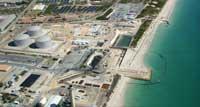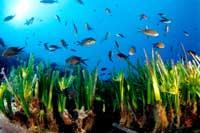Salt desalination poses a risk to the environment
2007/07/29 Galarraga Aiestaran, Ana - Elhuyar Zientzia

Despite the scarcity of water available to humans on the planet's total, its use is increasing, estimating that in the next two decades water use will increase by 40%. For the most part, about 70% is used in agriculture, and as the population grows, agriculture consumes more resources to produce food.
Apart from agriculture, water consumption in other sectors is increasing, especially in developed countries, while reducing water availability due, among other factors, to pollution.
Salado al desalar
Different ways are being tested to solve the problem. One of them is the desalination of sea water. According to WWF/Adena, in the Gulf of Arabia, 60% of freshwater needs are covered with desalinated water.

Desalinated water is also widely used in Spain. There are 700 desalination plants and desalinated water is used in agroturismos and dry areas. It should be noted that 22% of the water used in agriculture is desiccated marine water in Spain. In Australia, USA and Britain also has numerous desalination facilities, followed by those in China and India.
WWF/Adena just published this kind of eye-catching data in a report. But it has not only provided data, but also warns of the risks involved. In fact, according to WWF/Adena, desalination of seawater has harmful effects on the environment.
Seawater desalinators, like many other industries, consume a lot of energy and emit gases that increase global warming. According to WWF/Adena, for every cubic meter of water obtained, between 1 and 2 kilograms of carbon dioxide are released into the atmosphere.
Other implications are directly related to the activity carried out in these facilities. When desalinating water, water with high salt concentration is also obtained as a side product. This water is poured into the sea, seriously affecting the inhabitants of the place where it is poured. The condition to the marine plant Posidonia oceanica is especially serious.

Posidonia oceanica is strongly affected by discharges with high fat concentrations. (Photo: M. San Felix / University of Maryland)
Posidonia oceanica, natural of the Mediterranean, forms ‘meadows’ on the coast, in shallow waters. In the Mediterranean ecosystem it plays a very important role, maintaining the soil of the seabed and providing food and protection to thousands of animal species. Therefore, posidonia occupies a preferential place in the community directives on habitats.
For the growth of posidonia, the place must have two fundamental conditions: sunlight and the constant concentration of salts. Therefore, discharges from desalination facilities fail to meet this second condition.
Therefore, WWF/Adena considers that desalination of sea water does not solve the water problem. Therefore, it proposes to seek other solutions. In addition, it considers it essential to improve water management so as not to waste it and use it better than now.
Published in 7K.

Gai honi buruzko eduki gehiago
Elhuyarrek garatutako teknologia




